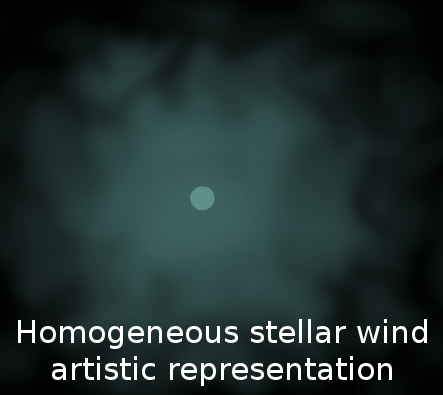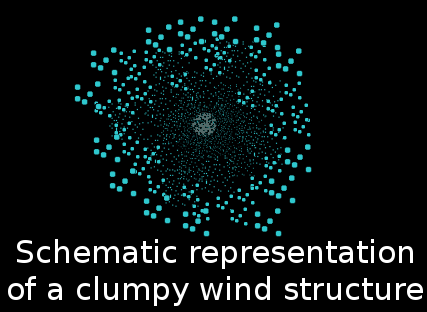 The first quantitative description of line-driving stellar winds
assumed stationary, homogeneous, and spherically symmetric outflows. The
initial models relied in stability of the outflow to the propagation of
velocity perturbations on spatial scales larger than the typical length
at which the outflow speed increases by thermal movement of ions (the
outflow speed is larger than the thermal speed). Stability analyses,
however, revealed that the line-driving of hot star winds is in fact
highly unstable, specially to velocity perturbations on spatial scales
on the order and below this lenght (known as the Sobolev length).
Observational evidence came from the detection of absorption troughs in
saturated UV lines and the suggestion of the presence of numerous shocks
throughout the wind from soft X-ray measurements.
The first quantitative description of line-driving stellar winds
assumed stationary, homogeneous, and spherically symmetric outflows. The
initial models relied in stability of the outflow to the propagation of
velocity perturbations on spatial scales larger than the typical length
at which the outflow speed increases by thermal movement of ions (the
outflow speed is larger than the thermal speed). Stability analyses,
however, revealed that the line-driving of hot star winds is in fact
highly unstable, specially to velocity perturbations on spatial scales
on the order and below this lenght (known as the Sobolev length).
Observational evidence came from the detection of absorption troughs in
saturated UV lines and the suggestion of the presence of numerous shocks
throughout the wind from soft X-ray measurements.
1-D and 2-D time-dependent numerical radiation-hydrodynamical simulations further showed that the non-linear growth of these instabilities leads to high-speed rarefactions that steepen into strong shocks, whereby most material is compressed into spatially narrow ‘clumps’ (or shells in 1-D simulations) separated by large regions of much lower densities. This characteristic structure in density and velocity is the theoretical basis for our current understanding and interpretation of wind clumping, and is supported by numerous observational and diagnostic studies in many different wavebands.
 Accounting
for wind clumping allows to consistently model the UV/optical and the
X-ray spectra of O-stars. Presently, clumping in first approximation
(“microclumping”) is taken into account in all up-to-date stellar wind
codes. This approximation assumes that clumps are optically thin and
that the interclump medium is void. Allowing for clumps of arbitrary
optical depth (“macroclumping”) is being nowadays included in full 3D
radiative transfer models of stellar winds.
Accounting
for wind clumping allows to consistently model the UV/optical and the
X-ray spectra of O-stars. Presently, clumping in first approximation
(“microclumping”) is taken into account in all up-to-date stellar wind
codes. This approximation assumes that clumps are optically thin and
that the interclump medium is void. Allowing for clumps of arbitrary
optical depth (“macroclumping”) is being nowadays included in full 3D
radiative transfer models of stellar winds.
The observational evidence of clumped winds comes also from the observation of accretion phenomena in High Mass X-ray binaries (HMXBs) where a compact object (a black hole or a neutron star) orbits a high mass star.
Goals of the project:
- · Collect and review observational phenomena which might be explained by wind clumping: X-ray flux variability, changes in fluorescence lines, etc.
- · Review the state of knowledge about wind models and their predictions for observed phenomena. E.g., the role of instabilities in wind accretion versus the variations caused by clumping.
- · Advance towards unified picture of massive star outflows in single stars and X-ray binaries, updating, if necessary, the classical papers.
- · Produce a consensus view allowing to describe all/most observed properties of specific sources, e.g., Vela X-1 or 4U 1700−37.
Our proposal to ISSI, titled "Unified View of Stellar Winds in Massive X-ray Binaries", can be downloaded HERE.
 Unified View of Stellar Winds in Massive X-ray Binaries
Unified View of Stellar Winds in Massive X-ray Binaries